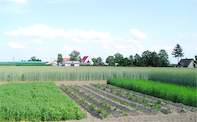Crop rotation is the variation of different crops in consecutive planting seasons. Annual crops (such as vegetables or grains) should not be planted in the same area for two consecutive years.

It must be alternated with other crops, because different crops take up or remove different nutrients from the soil. Synergism or crop rotation often occurs between certain crops if interchanged.
It simply means that a crop’s yield and quality can be increased if grown in a certain crop follow-up pattern. For example, measured over several years and localities, results of trials by Grain SA and the Agricultural Research Council Small Grain Institute show the yield of maize increased by an average of about 12% if grown after a leguminous crop.
Also, the yield of wheat after sunflower and a 13 month recovery period was 54% higher than that of the wheat monoculture system.
Advantages of Crop Rotation
Crop rotation helps to recycle nutrients. The most important example is legumes such as peas, beans, canola and lupin beans. These legumes have ‘nodes’ (nodules formed by the Rhizobium bacterium) on their roots that make nitrogen (N) for the plant.
There is a lot of nitrogen in the soil the next year after one of these crops has been planted. Other vegetables that need a lot of nitrogen can then be planted. Carrots do not need so many nutrients and can be planted two or three seasons after a legume. Crop rotation breaks the life cycle of weeds and pests.
Insects prefer certain plants to lay their eggs on or feed on. Insects will therefore lay their eggs on plants if they know there is food for the larva to eat as soon as it hatches. If the producer uses crop rotation on a specific piece of land every year, the insect’s life cycle is broken in such a way and it is also an environmentally friendly method of trying to control it. The idea is to alternate (rotate) crops that are not hosts of a particular plant disease.
According to Dr Belinda Janse van Rensburg of Agricultural Research Council Small Grain Institute is the correct identification of plant diseases, crop preferences and spreading of the disease crucial before a crop rotation system can be planned.
Crop Rotation Planning
Plan when different crops should be planted - rotate legumes with other crops. As mentioned, different crops have different nutritional needs. Crops with extensive root systems such as clover, barley and lucerne are good to use because they put a lot of organic material back into the soil.
These crops can also be used in rows to improve soil fertility and structure and to provide soil coverage. All plants (including vegetables) are divided into families and members of the same family are vulnerable to the same pests and diseases. Therefore the one should not be planted directly after the other in a crop rotation program.
Vegetables can be divided into the following crop groups:
Group A: Cabbage, cauliflower, broccoli, brussel sprouts, onion, leek, and garlic
Group B: Carrots, beetroot, swiss chard, turnips, sweet potato, celery and radishes
Group C: Tomatoes, potatoes, peppers, eggplant and lettuce
Group D: Pumpkins, squash, cucumber, watermelon and melon
Group E: Beans and peas.
An example of a vegetable crop rotation system works as follows: Divide the piece of land that will be used for vegetable production into five areas. Plant on area 1 vegetables of group A, area 2 vegetables of group B, area 3 vegetables of group C, area 4 vegetables of group D and area 5 vegetables of group E. The different groups shift on one area at a time each year.